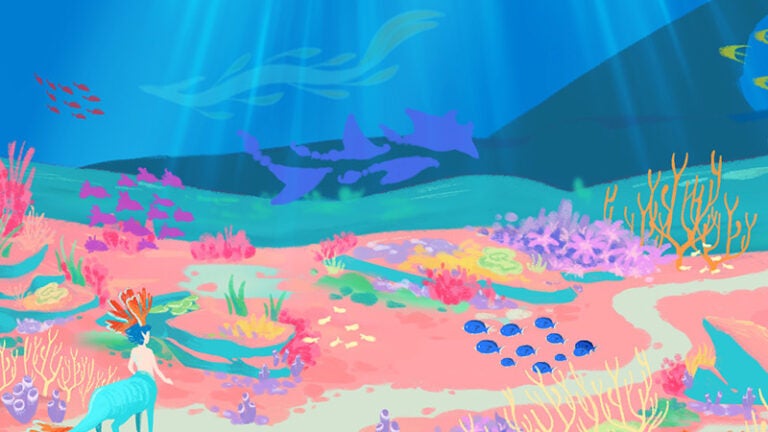
Environmental scholars guide students telling stories of ecology and conservation
The magical sea creature Thyota has a seemingly impossible task: to rid the ocean of pollution and save the coral forest. Consuming toxic contaminants and freeing other creatures are key to reaching this goal, but both come at a cost to Thyota’s own health. Traveling through the ocean, Thyota must make choices that will affect the entire marine ecosystem.
Thyota is the main character in a new game, titled “Metamorphosis: Thyota’s Journey,” under development at the USC School of Cinematic Arts and in collaboration with the USC Wrigley Institute for Environmental Studies, headquartered at the USC Dornsife College of Letters, Arts and Sciences.
The partnership pairs cinematic arts students with Wrigley Institute faculty and staff to create projects that convey scientific information in an engaging way. Through short films, animation, screenplays and other creations, students have presented research on issues such as biofuel, pollution, climate change and marine ecosystems.
“Because science and technology are progressing so rapidly and because we are having these big conversations in society about climate change and sustainability, these visual arts and storytelling products help go beyond presenting facts and actually create emotional connections to these topics,” says Jessica Dutton, associate director for research and engagement at the Wrigley Institute.
Dutton works with Kathy Smith, a professor and former chair of the John C. Hench Division of Animation and Digital Arts at the School of Cinematic Arts, to find students who might want to work with Wrigley Institute researchers, and Dutton and other staff members at the institute then pair the students with scientists in their field of interest.
The target audience varies by project. An animation titled “AquaPower,” about fish, microbes and plants, was designed as a teaching tool for elementary school students, whereas a short film on the kelp biofuel project — which features the “kelp elevator” — aims to communicate Wrigley Institute research to the general public.
“Students really like the novelty of these projects and the potential impact, and we want students to have the creative freedom to tell the concepts in their own way,” Dutton says.
Building empathy through gaming
Joanna Shen, the creator of “Metamorphosis” and a student in the Interactive Media and Games MFA program at the School of Cinematic Arts, says she contacted the Wrigley Institute after she saw the kelp biofuel program’s animation; her decision was fueled by her love of marine biology and her desire to raise awareness of marine conservation. She feels that interactive media is a powerful vehicle for conveying information and prompting an emotional engagement on the player’s part.
“I wanted players to think more eco-centrically and develop a little more real-world environmental empathy. By having these moments of consideration and reflection, we can slowly metamorphize our predisposed way of thinking,” she explains.
Shen went through this transformation herself while creating the game; through her work with Wrigley Institute researchers, she learned more about ocean pollution, the human factors involved in it and possible solutions and mitigations.
“Coming into this project, I let them know my game was going to be mostly a fantastical game with environmental elements embedded in it — it’s not going to be literal. And they were so supportive of what I wanted to do,” she says.
“Metamorphosis” will release on May 15 as a free to download.
Owls on film

USC Dornsife scholars advised students writing a screenplay about efforts to save the northern spotted owl. (Photo: WikiCommons/Kameron Perensovich.)
In another project, Walter Heymann and Amalia Mathewson, who are pursuing their MFAs in screenwriting, are developing a screenplay about efforts to save the northern spotted owl. Its designation as a “threatened” species in the 1970s led to the establishment of protections for the owl and its habitat, old growth forests in the Pacific Northwest.
Heymann says he first gained interested in the topic because he has a background in birdwatching, but he also found it interesting how scientists and environmental activists used the owl as the cute and cuddly face of forest conservation.
Mathewson agrees, noting that their screenplay also employs a similar tactic. “Owls are an essential character in the story we’re telling, but it’s really about old growth forests in the Pacific Northwest.”
She adds that in addition to consulting with Wrigley Institute personnel on scientific accuracy, they also are seeking their input for character development. “We want to be sure we’re not throwing out some sci-fi, invented version of what a scientist would do. We’re trying to be authentic and three-dimensional.”
Like Shen, Mathewson and Heymann want to convey the importance of environmental stewardship through their project without having the message come across too forcefully.
“We don’t want to hit the audience over the head with it, though; we want them to reach these conclusions themselves,” Heymann says.
Dutton says that she’s enjoyed seeing the creative ways science can be disseminated.
“I love these kinds of cross-campus collaborations. It reinforces the fact that all these disciplines need each other and derive value from each other.”